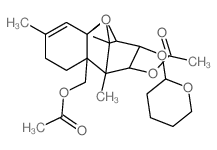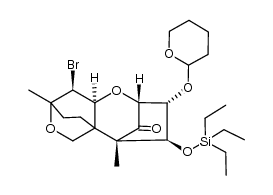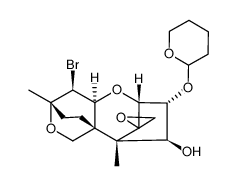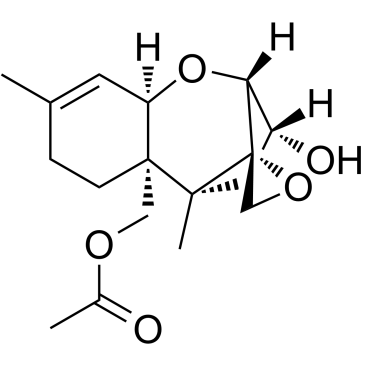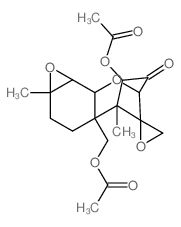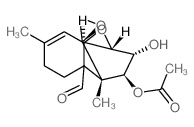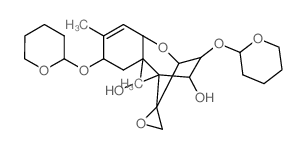2270-40-8
| 中文名 | 二乙酰镳草镰刀菌烯醇 |
|---|---|
| 英文名 | diacetoxyscirpenol |
| 中文别名 | 蛇形菌素 |
| 英文别名 |
Anguidin
Anguidin,DAS ANGUIDINE Diazetoxyskirpenol ang66 4,15-diacetoxyscirpenol 12-epianguidine (3β,4α,12R)-3-Hydroxy-12,13-epoxytrichothec-9-ene-4,15-diyl diacetate EINECS 218-873-3 MFCD00077621 MM 4462 (3α,4β,12R)-3-Hydroxy-12,13-epoxytrichothec-9-ene-4,15-diyl diacetate Diacetoxyscirpenol (3α,4β,12R)-3-Hydroxy-12,13-epoxytrichothec-9-en-4,15-diyldiacetat [(1S,2R,7R,9R,10R,11S,12R)-11-Acetoxy-10-hydroxy-1,5-dimethyl-2H-spiro[8-oxatricyclo[7.2.1.0]dodec-5-ene-12,2'-oxiran]-2-yl]methyl acetate |
| 描述 | Diacetoxyscirpenol (DAS) 是一种单端孢霉烯真菌毒素,是真菌的次生代谢产物。Diacetoxyscirpenol (DAS) 的摄入会引起人类和动物的血液病(中性粒细胞减少、再生障碍性贫血)。 |
|---|---|
| 相关类别 | |
| 参考文献 |
| 密度 | 1.3±0.1 g/cm3 |
|---|---|
| 沸点 | 471.2±45.0 °C at 760 mmHg |
| 熔点 | 162-164℃ |
| 分子式 | C19H26O7 |
| 分子量 | 366.405 |
| 闪点 | 162.8±22.2 °C |
| 精确质量 | 366.167847 |
| PSA | 94.59000 |
| LogP | 1.33 |
| 蒸汽压 | 0.0±2.7 mmHg at 25°C |
| 折射率 | 1.561 |
| 储存条件 | 2-8°C储存 |
| 分子结构 | 1、 摩尔折射率:92.00 2、 摩尔体积(m3/mol):288.8 3、 等张比容(90.2K):774.2 4、 表面张力(dyne/cm):51.6 5、 极化率(10 -24cm 3):36.47 |
| 计算化学 | 1、 疏水参数计算参考值(XlogP):0.2 2、 氢键供体数量:1 3、 氢键受体数量:7 4、 可旋转化学键数量:5 5、 互变异构体数量: 6、 拓扑分子极性表面积(TPSA):94.6 7、 重原子数量:26 8、 表面电荷:0 9、 复杂度:687 10、同位素原子数量:0 11、确定原子立构中心数量:7 12、不确定原子立构中心数量:0 13、确定化学键立构中心数量:0 14、不确定化学键立构中心数量:0 15、共价键单元数量:1 |
| 更多 | 1. 性状:未确定 2. 密度(g/L,20ºC):未确定 3. 相对蒸汽密度(g/mL,空气=1):未确定 4. 熔点(ºC):未确定 5. 沸点(ºC,常压):未确定 6. 沸点(ºC 12mmHg):未确定 7. 折射率(nD20):未确定 8. 闪点(ºC):2 9. 比旋光度():未确定 10. 自燃点或引燃温度(ºC):未确定 11. 蒸气压(Pa,25ºC):未确定 12. 饱和蒸气压(kPa,20ºC):未确定 13. 燃烧热(KJ/mol):未确定 14. 临界温度(ºC):未确定 15. 临界压力(KPa):未确定 16. 油水(辛醇/水)分配系数的对数值:未确定 17. 爆炸上限(%,V/V):未确定 18. 爆炸下限(%,V/V):未确定 19. 溶解性:未确定 |
|
SECTION 1: Identification of the substance/mixture and of the company/undertaking Product identifiers Product name: Diacetoxyscirpenol solution Index-No.: 608-001-00-3 REACH No.: A registration number is not available for this substance as the substance or its uses are exempted from registration, the annual tonnage does not require a registration or the registration is envisaged for a later
registration deadline. CAS-No.: 2270-40-8 Relevant identified uses of the substance or mixture and uses advised against Identified uses: Laboratory chemicals, Manufacture of substances SECTION 2: Hazards identification Classification of the substance or mixture Classification according to Regulation (EC) No 1272/2008 Flammable liquids (Category 2), H225 Acute toxicity, Oral (Category 4), H302 Acute toxicity, Inhalation (Category 4), H332 Acute toxicity, Dermal (Category 4), H312 Eye irritation (Category 2), H319 For the full text of the H-Statements mentioned in this Section, see Section 16. Classification according to EU Directives 67/548/EEC or 1999/45/EC F Highly flammableR11 Xn HarmfulR20/21/22 Xi IrritantR36 For the full text of the R-phrases mentioned in this Section, see Section 16. Label elements Labelling according Regulation (EC) No 1272/2008 Pictogram Signal wordDanger Hazard statement(s) H225Highly flammable liquid and vapour. H302Harmful if swallowed. H312Harmful in contact with skin. H319Causes serious eye irritation. H332Harmful if inhaled. Precautionary statement(s) P210Keep away from heat/sparks/open flames/hot surfaces. - No smoking. P280Wear protective gloves/ protective clothing. P305 + P351 + P338IF IN EYES: Rinse cautiously with water for several minutes. Remove contact lenses, if present and easy to do. Continue rinsing. Supplemental Hazardnone Statements According to European Directive 67/548/EEC as amended. Hazard symbol(s)F Highly flammable Xn Harmful R-phrase(s) R11Highly flammable. R20/21/22Harmful by inhalation, in contact with skin and if swallowed. R36Irritating to eyes. S-phrase(s) S16Keep away from sources of ignition - No smoking. S36/37Wear suitable protective clothing and gloves. Other hazards - none SECTION 3: Composition/information on ingredients Mixtures Chemical characterization : Natural product Synonyms: 12,13-Epoxytrichothec-9-ene-3,4,15-triol-4,15-diacetatesolution Anguidinsolution 4β,15-Diacetoxy-3α-hydroxy-12,13 epoxy-trichothec-9-enesolution DAS Formula: C19H26O7 C19H26O7 Molecular Weight: 366,41 g/mol Hazardous ingredients according to Regulation (EC) No 1272/2008 ComponentClassificationConcentration Acetonitrile CAS-No.75-05-8Flam. Liq. 2; Acute Tox. 4; Eye <= 100 % EC-No.200-835-2Irrit. 2; H225, H302 + H312 + Index-No.608-001-00-3H332, H319 Registration number01-2119471307-38-XXXX Hazardous ingredients according to Directive 1999/45/EC ComponentClassificationConcentration Acetonitrile CAS-No.75-05-8F, Xn, R11 - R20/21/22 - R36 <= 100 % EC-No.200-835-2 Index-No.608-001-00-3 Registration number 01-2119471307-38-XXXX For the full text of the H-Statements and R-Phrases mentioned in this Section, see Section 16 SECTION 4: First aid measures Description of first aid measures General advice Consult a physician. Show this safety data sheet to the doctor in attendance. If inhaled If breathed in, move person into fresh air. If not breathing, give artificial respiration. Consult a physician. In case of skin contact Wash off with soap and plenty of water. Consult a physician. In case of eye contact Rinse thoroughly with plenty of water for at least 15 minutes and consult a physician. If swallowed Do NOT induce vomiting. Never give anything by mouth to an unconscious person. Rinse mouth with water. Consult a physician. Most important symptoms and effects, both acute and delayed The most important known symptoms and effects are described in the labelling (see section 2.2) and/or in section 11 Indication of any immediate medical attention and special treatment needed no data available SECTION 5: Firefighting measures Extinguishing media Suitable extinguishing media Use water spray, alcohol-resistant foam, dry chemical or carbon dioxide. Special hazards arising from the substance or mixture Carbon oxides, nitrogen oxides (NOx) Advice for firefighters Wear self contained breathing apparatus for fire fighting if necessary. Further information Use water spray to cool unopened containers. SECTION 6: Accidental release measures Personal precautions, protective equipment and emergency procedures Use personal protective equipment. Avoid breathing vapours, mist or gas. Ensure adequate ventilation. Remove all sources of ignition. Evacuate personnel to safe areas. Beware of vapours accumulating to form explosive concentrations. Vapours can accumulate in low areas. For personal protection see section 8. Environmental precautions Prevent further leakage or spillage if safe to do so. Do not let product enter drains. Methods and materials for containment and cleaning up Contain spillage, and then collect with an electrically protected vacuum cleaner or by wet-brushing and place in container for disposal according to local regulations (see section 13). Reference to other sections For disposal see section 13. SECTION 7: Handling and storage Precautions for safe handling Avoid contact with skin and eyes. Avoid inhalation of vapour or mist. Keep away from sources of ignition - No smoking.Take measures to prevent the build up of electrostatic charge. For precautions see section 2.2. Conditions for safe storage, including any incompatibilities Store in cool place. Keep container tightly closed in a dry and well-ventilated place. Containers which are opened must be carefully resealed and kept upright to prevent leakage. Recommended storage temperature: -20 °C Handle and store under inert gas. Specific end use(s) Apart from the uses mentioned in section 1.2 no other specific uses are stipulated SECTION 8: Exposure controls/personal protection Control parameters Components with workplace control parameters Exposure controls Appropriate engineering controls Handle in accordance with good industrial hygiene and safety practice. Wash hands before breaks and at the end of workday. Personal protective equipment Eye/face protection Tightly fitting safety goggles. Faceshield (8-inch minimum). Use equipment for eye protection tested and approved under appropriate government standards such as NIOSH (US) or EN 166(EU). Skin protection Handle with gloves. Gloves must be inspected prior to use. Use proper glove removal technique (without touching glove's outer surface) to avoid skin contact with this product. Dispose of contaminated gloves after use in accordance with applicable laws and good laboratory practices. Wash and dry hands. The selected protective gloves have to satisfy the specifications of EU Directive 89/686/EEC and the standard EN 374 derived from it. Full contact Material: Fluorinated rubber Minimum layer thickness: 0,7 mm Break through time: 480 min Material tested:Vitoject® (KCL 890 / Z677698, Size M) Splash contact Material: butyl-rubber Minimum layer thickness: 0,3 mm Break through time: 480 min Material tested:Butoject® (KCL 897 / Z677647, Size M) data source: KCL GmbH, D-36124 Eichenzell, phone +49 (0)6659 87300, test method: EN374 If used in solution, or mixed with other substances, and under conditions which differ from EN 374, contact the supplier of the CE approved gloves. This recommendation is advisory only and must be evaluated by an industrial hygienist and safety officer familiar with the specific situation of anticipated use by our customers. It should not be construed as offering an approval for any specific use scenario. Body Protection Complete suit protecting against chemicals, Flame retardant antistatic protective clothing, The type of protective equipment must be selected according to the concentration and amount of the dangerous substance at the specific workplace. Respiratory protection Where risk assessment shows air-purifying respirators are appropriate use a full-face respirator with multi-purpose combination (US) or type ABEK (EN 14387) respirator cartridges as a backup to engineering controls. If the respirator is the sole means of protection, use a full-face supplied air respirator. Use respirators and components tested and approved under appropriate government standards such as NIOSH (US) or CEN (EU). Control of environmental exposure Prevent further leakage or spillage if safe to do so. Do not let product enter drains. SECTION 9: Physical and chemical properties Information on basic physical and chemical properties a) AppearanceForm: liquid b) Odourno data available c) Odour Thresholdno data available d) pHno data available e) Melting point/freezingMelting point/range: -45 °C point f) Initial boiling point and 81 - 82 °C at 1.013 hPa boiling range g) Flash point2 °C h) Evapouration rate5,79 i) Flammability (solid, gas) no data available j) Upper/lowerUpper explosion limit: 16 %(V) flammability orLower explosion limit: 4,4 %(V) explosive limits k) Vapour pressureno data available l) Vapour densityno data available m) Relative density0,782 g/cm3 n) Water solubilityno data available o) Partition coefficient: n- log Pow: -0,34 octanol/water p) Auto-ignition274 °C temperature q) Decompositionno data available temperature r) Viscosityno data available s) Explosive propertiesno data available t) Oxidizing propertiesno data available Other safety information no data available SECTION 10: Stability and reactivity Reactivity no data available Chemical stability Stable under recommended storage conditions. Possibility of hazardous reactions no data available Conditions to avoid Heat, flames and sparks. Extremes of temperature and direct sunlight. Incompatible materials Bases, Oxidizing agents, Alkali metals, Reducing agents, acids Hazardous decomposition products In the event of fire: see section 5 SECTION 11: Toxicological information Information on toxicological effects Acute toxicity no data available Skin corrosion/irritation no data available Serious eye damage/eye irritation no data available Respiratory or skin sensitisation no data available Germ cell mutagenicity no data available Carcinogenicity IARC:No component of this product present at levels greater than or equal to 0.1% is identified as probable, possible or confirmed human carcinogen by IARC. Reproductive toxicity no data available Specific target organ toxicity - single exposure no data available Specific target organ toxicity - repeated exposure no data available Aspiration hazard no data available Additional Information RTECS: Not available Treat as cyanide poisoning., Always have on hand a cyanide first-aid kit, together with proper instructions., The onset of symptoms is generally delayed pending conversion to cyanide., Headache, Dizziness, Rash, Cyanosis, excitement, depression, Drowsiness SECTION 12: Ecological information Toxicity no data available Persistence and degradability no data available Bioaccumulative potential no data available Mobility in soil no data available Results of PBT and vPvB assessment PBT/vPvB assessment not available as chemical safety assessment not required/not conducted Other adverse effects no data available SECTION 13: Disposal considerations Waste treatment methods Product Burn in a chemical incinerator equipped with an afterburner and scrubber but exert extra care in igniting as this material is highly flammable. Offer surplus and non-recyclable solutions to a licensed disposal company. Contaminated packaging Dispose of as unused product. SECTION 14: Transport information UN number ADR/RID: 1648IMDG: 1648IATA: 1648 UN proper shipping name ADR/RID: ACETONITRILE, SOLUTION IMDG: ACETONITRILE, SOLUTION IATA:Acetonitrile, SOLUTION Transport hazard class(es) ADR/RID: 3IMDG: 3IATA: 3 Packaging group ADR/RID: IIIMDG: IIIATA: II Environmental hazards ADR/RID: noIMDG Marine pollutant: noIATA: no Special precautions for user no data available SECTION 15: Regulatory information This safety datasheet complies with the requirements of Regulation (EC) No. 1907/2006. Safety, health and environmental regulations/legislation specific for the substance or mixture no data available Chemical Safety Assessment For this product a chemical safety assessment was not carried out SECTION 16: Other information Full text of H-Statements referred to under sections 2 and 3. Acute Tox.Acute toxicity Eye Irrit.Eye irritation Flam. Liq.Flammable liquids H225Highly flammable liquid and vapour. H302Harmful if swallowed. H302 + H312 +Harmful if swallowed, in contact with skin or if inhaled H332 H312Harmful in contact with skin. H319Causes serious eye irritation. H332Harmful if inhaled. Full text of R-phrases referred to under sections 2 and 3 FHighly flammable XnHarmful R11Highly flammable. R20/21/22Harmful by inhalation, in contact with skin and if swallowed. R36Irritating to eyes. Further information Copyright 2014 Co. LLC. License granted to make unlimited paper copies for internal use only. The above information is believed to be correct but does not purport to be all inclusive and shall be used only as a guide. The information in this document is based on the present state of our knowledge and is applicable to the product with regard to appropriate safety precautions. It does not represent any guarantee of the properties of the product. Corporation and its Affiliates shall not be held liable for any damage resulting from handling or from contact with the above product. See and/or the reverse side of invoice or packing slip for additional terms and conditions of sale. |
CHEMICAL IDENTIFICATION
HEALTH HAZARD DATAACUTE TOXICITY DATA
MUTATION DATA
|
| 危害码 (欧洲) | T+,T,Xn,F |
|---|---|
| 风险声明 (欧洲) | 26/27/28-36/38-36-20/21/22-11 |
| 安全声明 (欧洲) | S45;S53 |
| 危险品运输编码 | UN 3462 6.1/PG 2 |
| WGK德国 | 3 |
| RTECS号 | YD0112000 |
| 包装等级 | II |
| 危险类别 | 6.1(a) |
| 海关编码 | 29329990 |
|
~% 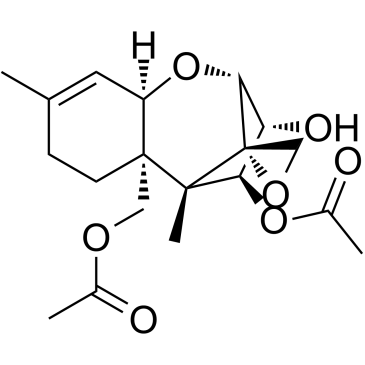
2270-40-8 |
| 文献:Journal of Organic Chemistry, , vol. 52, # 4 p. 603 - 606 |
|
~% 
2270-40-8 |
| 文献:Journal of Organic Chemistry, , vol. 52, # 4 p. 603 - 606 |
|
~% 
2270-40-8 |
| 文献:Journal of Organic Chemistry, , vol. 52, # 4 p. 603 - 606 |
|
~% 
2270-40-8 |
| 文献:Journal of Organic Chemistry, , vol. 52, # 4 p. 603 - 606 |
| 上游产品 3 | |
|---|---|
| 下游产品 10 | |


